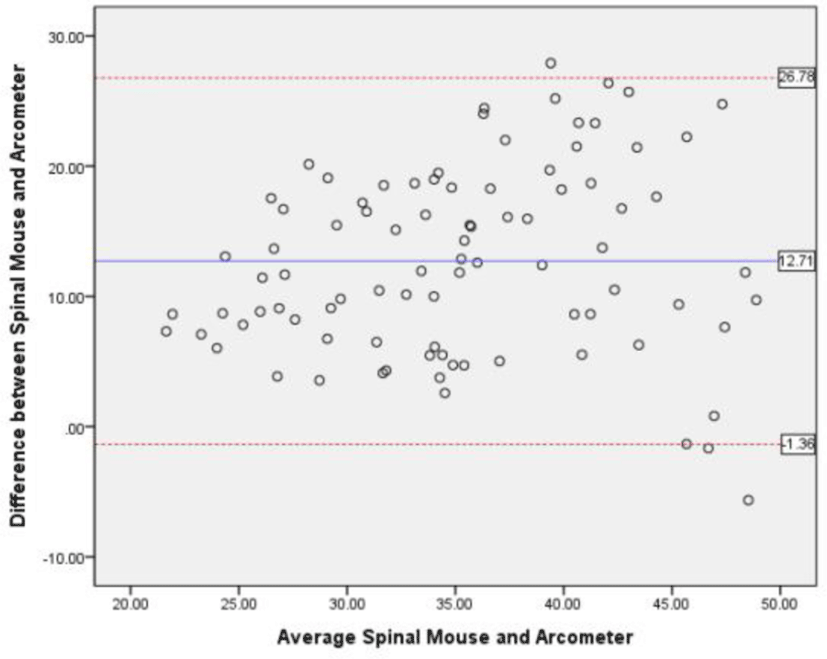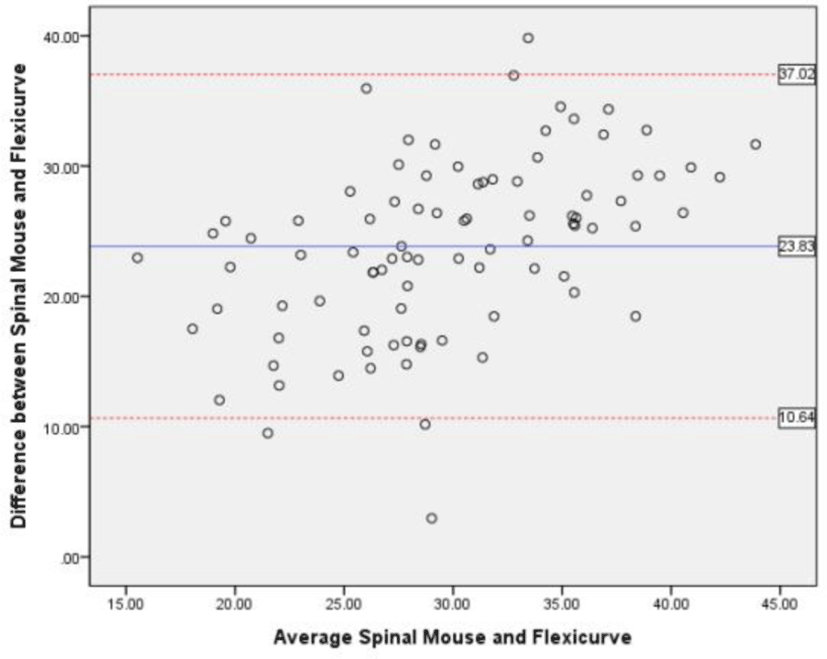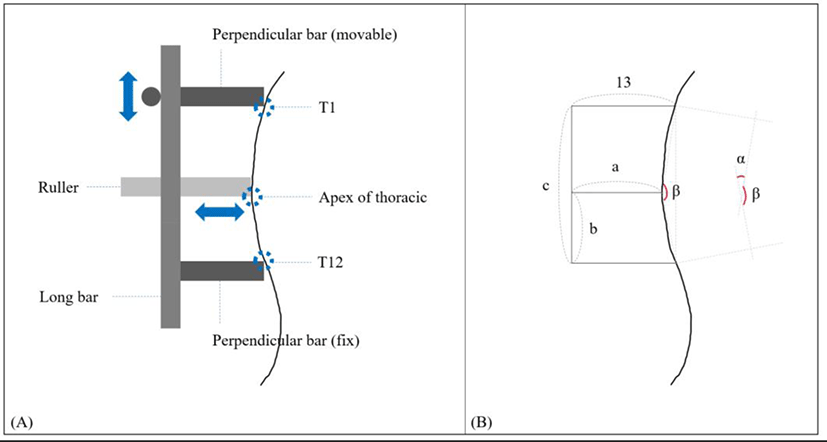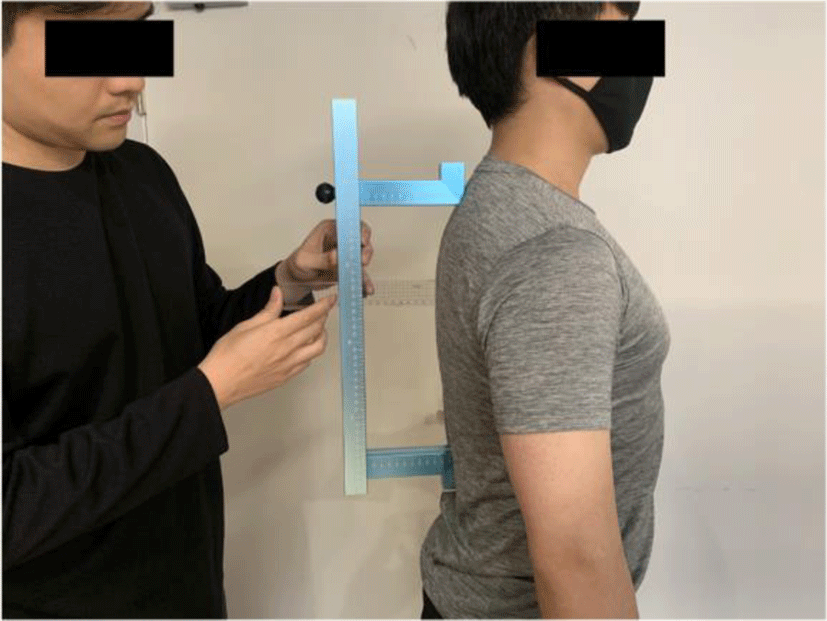INTRODUCTION
Thoracic hyperkyphosis is greater than 40 degrees of a thoracic cobb angle in sagittal plane.1 The curvature of the thoracic vertebrae generally increases with age, and in recent years, the hyperkyphosis is frequently observed between the 20s and 50s while using digital devices such as computers and smartphones.2-5 Thoracic hyperkyphosis reduces balance and increases the risk of falls.6 In addition, musculoskeletal problems such as neck pain, shoulder pain, and back pain are also associated with thoracic hyperkyphosis.7-9
It is important for physical therapist to measure thoracic kyphosis because thoracic hyperkyphosis have negative health consequences.10 The Cobb angle calculated by sagittal plane spinal radiograph is considered the gold standard in thoracic kyphosis measurements.11 However, the limitations of radiographic measurements are cost, portability limitations, time consuming, and exposure to ionizing radiation.12,13 For this reason, non-radiological methods are preferred in clinical settings, and Spinal Mouse, Flexicurve and Arcometer has previously demonstrated excellent level of validity and intra-inter-rater reliability in previous studies.14 These devices have the advantage of being portable without being exposed to ionizing radiation.
Non-radiological methods are skin-surface devices.14,15 The Spinal Mouse measures the thoracic curve continuously throughout the thoracic spine, and the Flexicurve and Arcometer calculates the thoracic curve by placing the tool at a selected location on the thoracic spine.14 If the correlation between the value calculated through continuous measurement and calculated through selective measurement is demonstrated, the accuracy and correlation of the measured values with each tool can be understood and applied to therapy. Therefore, the purpose of this study was to investigate the correlation among Spinal mouse, Flexicurve and Arcometer.
METHOD
People who thought they had thoracic hyperkyphosis were recruited as subjects between 18 and 50 years. Exclusion criteria were (1) participants with scoliosis, (2) a history of spinal column fracture, (3) spinal tumors and related malignancies, (3) congenital spinal anomalies, (4) cancer, and (5) rheumatoid arthritis. Before the experiment, the participants were explained by all procedures of the experimental process. Each provided and signed informed consent on a form approved by the Yonsei University, Mirae Campus, Institutional Review Board (1041849-201901-BM-019-01).
Sagittal spinal curvatures were measured in the standing position at staring straight ahead using a Spinal Mouse system (Idiag, Fehraltdorf, Switzerland). The Spinal Mouse has accelerometers that record change of inclination and intersegmental distance of spinous processes. The device contains two rolling wheels follow the spinous processes of the spine, and the data are transferred from the device to a computer (sampling frequency of approximately 150 Hz).16 This data is used to calculate the relative angles between the vertebras and total angle of sagittal plane with using Spinal Mouse software. For global spinal angles, the device is a reliable and valid device.17-19
The Flexicurve kyphosis angle was measured using a Flexicurve.10,20 The cephalic end of the Flexicurve was placed at C7 and it was molded to the contour of the thoracic spine in the caudal direction. The Flexicurve was then carefully transferred to paper. Next, a photograph of the Flexicurve imprint was captured using Smartphone camera (Iphone 8, Apple Inc, California). Using a tripod, the camera was parallel to the floor and fixed above 1 m. The Flexicurve angle was analysis using ImageJ (National Institutes of Health, Bethesda, MD) and calculated according to the previous study.10,20 The validity and reliability of the measurements from the Flexicurve method have been demonstrated in previous studies.21-25
An Arcometer is a method of inferring a thoracic kyphosis angle by measuring several lengths.26 The validity and reliability of the measurements from the Arcometer method have been demonstrated by D’Osualdo (1997). In this study, a modified Arcometer manufactured by our team was used (Figure 1A). The modified Arcometer is a tool consisting of a long bar and two smaller, perpendicular bars. Each bar is marked with millimeters. The first perpendicular bar is fixed at one end; the second, movable on a single axis. For measuring thoracic kyphosis, the first bar is placed at T1 and the second bar is placed at T12. Then, the ruler is pierced through a long bar at the apex between T1 and T12 (Figure 2). The tool can provide the three lengths and the thoracic kyphosis angle was calculated according to the following formula (Figure 1B):
The statistical analyses were performed using the statistical software package Statistical Package for the Social Sciences (SPSS) version 20.0 (SPSS Inc., Chicago, IL), and the level of statistical significance was set at p<0.05. The Kolmogorov-Smirnov test was used to assess the homogeneity of variance of the Arcometer and Spinal mouse measurement (p>0.05). The correlation among the non-radiological measurement for thoracic kyphosis was assessed by calculating the ICC [3,1]. ICC values >0.75 were considered excellent; 0.40–0.75 indicated fair to good; and 0.00–0.40 indicated poor.27 Bland-Altman limits of agreement analysis was used to assess the relative agreement between measurements (Spinal Mouse–Flexicurve and Spinal Mouse–Arcometer).28
RESULT
A total of 89 subjects participated in the study analysis due to loss of data among 5 of the 94 recruited. Eighty-eight subjects (age=35.25±6.71 years; height=169.37±7.34 cm; mass=71.31±15.24 kg) participated in this study. Table 1 displays a description of the thoracic kyphosis values obtained from the Spinal Mouse, Flexicurve and Arcometer.
| Mean (°) | Standard deviation (°) | Minimum (°) | Maximum (°) | |
|---|---|---|---|---|
| Spinal Mouse | 41.65 | 8.24 | 25.3 | 59.7 |
| Flexicurve | 17.82 | 5.39 | 4.05 | 29.14 |
| Arcometer | 28.96 | 7.40 | 17.62 | 51.35 |
The correlation between the Spinal mouse and Flexicurve measurements of thoracic kyphosis was good (ICC=0.53, 95% CI=0.37–0.67). And the correlation between the Spinal Mouse and Arcometer measurements of thoracic kyphosis was good (ICC=0.58, 95% CI=0.42–0.70). The correlation between the Arcometer and Flexicurve measurements of thoracic kyphosis was good (ICC=0.42, 95% CI=0.24–0.58). The mean difference between the Spinal Mouse and Arcometer was 12.70° (Spinal Mouse–Arcometer), between the Spinal mouse and Flexicurve was 23.83° (Spinal Mouse–Flexicurve) (Bland-Altman plots) (Figure 3, 4). In addition, there were few outliers beyond two SDs of the mean difference. Therefore, the Arcometer tended to consistently produce measurements that were approximately 12.7° lower than those of the Spinal Mouse and Flexicurve tended to consistently produce measurement that were approximately 23.83° lower than those of the Spinal Mouse.


DISCUSSION
This study investigated the correlation between non-radiological measurements. To reduce exposure to ionizing radiation in clinical settings, non-radiological methods are often used to measure thoracic kyphosis in patients.12,13 Since there are a variety of non-radiological methods to measure thoracic kyphosis, the results of the correlation among non-radiological methods will help clinicians treat patients.
In the previous study, the range of the Cobb angle measured by the radiography was 20.3°–66.3°.29 Among the methods used in this study, the range of the thoracic kyphosis measured by the Spinal Mouse (25.3°–59.7°) had the most similar range to the previous study measured by the radiography. However, the Flexicurve and Arcometer showed the range of 4.05°–29.14° and 17.62°–51.35°, respectively, showing a large difference from the range in the previous study measured by the radiography. Since the Spinal Mouse is a continuous measurement method, it may have a range similar to that of the radiography than the selective measurement method of Flexicurve and Arcometer.14
The average difference between Spinal Mouse and Flexicurve is greater than the average difference between Spinal Mouse and Arcometer. For measurement of the thoracic kyphosis, the Arcometer places the tool on the thoracic spine in the standing and simultaneously measures the length value, while the Flexicurve places the tool on the thoracic spine, tracks the shape, takes a picture, and measures it through the program.20 The process using Flexicurve is more complicated than the process using Arcometer, and the measurement and analysis mistakes that can occur in this process can make an average difference.
Our study has several limitations. First, we enrolled only healthy, relatively young subjects (35.25±6.71 years). Thus, our findings cannot be generalized to any patient population, to subjects with old-age. Second, we measured single measurement. Repeated measurements may have yielded different results.
CONCLUSIONS
The selective measurements (Flexicurve, Arcometer) are highly correlated to the continuous measurement (Spinal Mouse). However, they have poor agreement (mean difference: Arcometer 12.70°, Flexicurve 23.83°). Therefore, physical therapists should take caution when interpreting its results.









